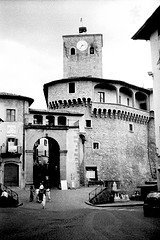La Dolce Vita
 Good friends of ours, a lovely half English half Italian girl and her Argentine partner, Madeline and Julio, have just come back from a relaxing trip to northern Italy visiting her grandparents.
Good friends of ours, a lovely half English half Italian girl and her Argentine partner, Madeline and Julio, have just come back from a relaxing trip to northern Italy visiting her grandparents.I was really pleased to hear that Julio had a wonderful time on his first trip to the country. He had heard both his girlfriend and myself raving endlessly about the quality of ingredients; the gelato, the coffee, the pasta and the pizza but was not convinced. I suppose no description of the ocean is going to prepare someone fully for their first encounter; in Julio's case it was authentic Italian cuisine. Reportedly, he is now a convert and a changed man.
I do miss a good coffee; not only ones made with quality beans but by a skilled barista. I have yet to find a caffè or espresso with a layer of smooth, golden crema sitting on top. The proportion of foam and fluffed milk in the top layer of a proper cappuccino is another test of a good barista which no one behind any coffee machine in this city has passed yet.
Gelati; lampone, nocciola, pistachio are just a few of the flavours I dream of...Ice creams made with loads of fresh fruits or nuts, and most importantly, less sugar and no colouring. When Guillermo first tasted a real gelato, he didn't like it very much because it was not as sweet or gunky as Argentine helados. However, after a couple of years of retraining his taste buds, he appreciates the subtle flavours, delicate textures and quality ingredients now.
Since caffè normale and ice creams cannot be packed in a suitcase, I am most excited with my new possession – 500g of pine nuts (pinoli in Italian, piñones in Spanish). I have been thinking about what to do with them; pesto with fresh basilico is a given, may be a torta della Nonna (Grandmother's pie; a pine nut tart), and if I could find peppery wild rocket and an aged aceto balsamico (balsamic vinegar) I would make a simple pasta dish, Claudia, my friend in Molazzana, used to make for us.
Molazzana is a little village at the foot of the Apuan Alps in La Garfagnana region of Toscana. The closest town is the ancient walled township of Lucca. There is also a Slow Food Chapter in Castelnuovo di Garfagnana close by.
During winter, Claudia and I used to drive to Castelnuovo to visit the wine bar owned by Andrea (Andrew), Director of this local Chapter. The little corner shop was ancient and walls were lined with bottles up to the top, 5 metres high. There was a big communal table in the middle where customers were served Chianti, Barolo, Barbaresco, etc. by the glass, sommelier glass I might add.
Since Italian wines are made to be enjoyed with food, we usually ordered a platter of prosciutto, cotto (cooked) and crudo (cured), mixed with Tuscan lardo (cured lard) and some freshly baked sourdough bread - the pure and simple tastes of a rustic heaven.
The region is famous for chestnuts and the ancient grain of the Legions, farro (spelt). Chestnuts are heavily featured in autumn and winter dishes. Flour is ground from the nuts and used to make fresh pasta. The most memorable pasta dish I have ever had was a simple chestnut tagliatelle with wild boar ragú; it was autumnal Tuscany on a plate.
Spelt has become a fashionable grain in London and Sydney in recent years. It is preferred over wheat due to its lower gluten content, therefore more digestible. Whole spelt are used in soups and stews while the flour is used in bread making. Spelt flour is also commonly used to make pasta in La Garfagnana. The pasta takes on a nutty flavour and texture, similar to wholemeal pasta but much lighter on one's digestive system.
Claudia's pasta di farro was a simple dish taught to her by the family's Sardinian house keeper when she was a little girl. Agro-dolce (sweet and sour) is the signature flavour of the emerald island.
She sautéed a handful of pine nuts in a pan with a slug of good olive oil, then added some raisins and balsamic vinegar. When the raisins had puffed up and regained their original form, cooked spelt pasta was folded into the thin sauce, followed by wild rocket leaves. The residual heat of the pasta wilted the spiky leaves just enough. The dish was served at the table with just a scant sprinkling of grano pandano or parmigiano reggiano. Viva Italia!


<< Home